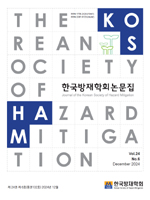본 연구의 목적은 미세먼지로 인한 위험성과 취약성에 대한 공간분석을 통해 실효성있는 대기환경정책 의사결정지원 방안을 제시하는 것이다. 이를 위해, 미세먼지의 위험성과 취약성을 조작적으로 정의하고, 청주시를 사례지로 하여 공간화한 후, 위험성과 취약성간의 공간관계를 해석하고 정책적 함의를 도출하였다. 연구결과, 사례지내에서 공업지역 비율이 높은 지역이면서 신축아파트 단지 및 학교와 인접해있는 신도심 지역과 표고가 낮고, 도심공원 비율이 낮으면서 노후주택이 밀집해있는 구도심 지역 등이 우선 관리 지역으로 도출되었다. 도출된 지역은 고농도 집중관리구역 선정 후보지가 될 수 있으며, 배출저감시설 설치·배분 및 취약집단 지원 사업시행시 우선 지역으로 검토될 수 있다. 더불어, 본 연구는 국토환경 통합관리에 있어 대기부문 공간환경 정책 수립과 건강 형평성을 고려한 대기환경 정책 수립의 근거로도 활용할 수 있다.
This study presented an effective decision-making support plan for air-quality policy through a spatial analysis of the risks and vulnerabilities associated with particulate matter. The study defined the risks and vulnerabilities of particulate matter operationally, mapped Cheongju-Si as a case study, interpreted the spatial relationship between risk and vulnerability, and explored policy implications. New urban areas with a high proportion of industrial areas and adjacent to new housing estates and schools and old urban areas with low ground levels, a low proportion of urban parks, and a high concentration of old houses were identified as areas for priority management. The identified areas may be candidates for high-concentration intensive management and may be considered priority areas for the installation and distribution of emission-reduction equipment and the implementation of projects to support vulnerable groups. This study’s findings may be used as a basis for establishing both spatial environmental policies for the air sector in the integrated management of the land environment and air environmental policies that consider health equity.
1. 서 론
2. 이론 및 선행연구의 고찰
3. 연구 방법론
4. 분석 및 고찰
5. 결 론
감사의 글
References
